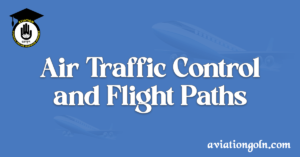Air traffic control (ATC) is a crucial component of modern aviation that ensures the safe and organized movement of aircraft within the airspace and on the ground at airports. Its core responsibility is to prevent collisions between aircraft in the air and between aircraft and obstructions on the ground. Additionally, ATC provides the support needed to ensure efficient flight paths for all aircraft, whether they’re commercial airliners, private planes, or military jets. The intricacies of air navigation are deeply intertwined with the activities of ATC, and understanding this relationship sheds light on how millions of passengers safely traverse the skies each day.
Air Traffic Control and Flight Paths

1. Introduction to Air Traffic Control
a. Historical Background
The need for organized air traffic control began with the rapid expansion of air travel in the early 20th century. Initial systems were rudimentary, primarily relying on visual signals. With the advent of radar technology during World War II, the potential for systematic and organized control over busy airspaces became evident. Post-war, the world witnessed a dramatic rise in commercial air traffic, further necessitating an organized ATC system.
b. Role of ATC
The main objective of ATC is to prevent collisions by ensuring that aircraft maintain safe distances from one another. They manage aircraft movements on the runways and taxiways of an airport, and in the vast airspace, as planes fly between airports. Controllers provide pilots with instructions on when to climb, descend, turn, or maintain their course.
2. Components of Air Traffic Control
a. Control Towers
Located at airports, these towers handle the landing and takeoff of aircraft. Controllers in these towers have a clear view of the airport and use a combination of visual observations and radar data to manage local traffic.
b. Terminal Radar Approach Control (TRACON)
These facilities handle aircraft as they approach and leave airports, typically covering a radius of about 40-50 miles from the main airport.
c. Area Control Centers (ARTCCs or Centers)
Centers control aircraft that are flying at cruising altitudes, typically between airports. There are several of these centers across large countries, and each one manages a specific piece of airspace.
3. Flight Paths & Navigation
a. Flight Plan
Before a flight takes off, a flight plan is filed with ATC. This plan contains details about the aircraft, the intended route, cruising altitude, and other relevant data. ATC uses this plan to anticipate the aircraft’s movements and provide necessary clearances.
b. Air Routes
Aircraft don’t simply fly in a straight line from origin to destination. They follow predefined routes in the sky known as airways. These airways are like highways in the sky, connecting specific navigation aids (navaids) and waypoints. Each airway has a designated minimum altitude that ensures safety from obstacles and other traffic.
c. Navigation Aids (Navaids)
These are ground-based radio transmitters that aircraft use for navigation. Examples include VOR (VHF Omnidirectional Range) and NDB (Non-Directional Beacon). Aircraft instruments pick up signals from these navaids to determine their position.
d. Global Navigation Satellite Systems (GNSS)
Satellite-based systems like GPS allow aircraft to determine their position with high accuracy. Modern aircraft use a combination of traditional navaids and GNSS for navigation.
e. Altitude Levels
To prevent collisions, aircraft flying in opposite directions are assigned different altitudes. For example, eastbound flights might fly at odd-numbered altitudes (e.g., 33,000 feet), while westbound flights use even-numbered altitudes (e.g., 32,000 feet).
4. Challenges and Innovations
a. Air Traffic Congestion
As air travel becomes more popular, managing congested skies is a significant challenge. More aircraft in the sky mean busier airways and airports, which can lead to delays and increased fuel consumption.
b. NextGen and SESAR
These are initiatives in the U.S. and Europe, respectively, aiming to modernize air traffic management. They leverage new technologies to improve the efficiency and safety of air travel. Concepts under these initiatives include real-time data sharing between aircraft and ATC, improved flight routing, and more.
c. Unmanned Aircraft Systems (UAS)
The rise of drones presents new challenges for ATC. Managing a mix of manned and unmanned aircraft requires new protocols and technologies.
5. Conclusion
Air traffic control is an evolving field that requires a delicate balance between human judgment and technological assistance. As we look to the future, innovations promise to enhance the efficiency, safety, and sustainability of air travel. However, the primary mission of ATC will always remain the same: to ensure that every individual who takes to the skies reaches their destination safely.
This overview touches on many aspects of air traffic control and air navigation. Each section can be expanded further for an in-depth understanding. For those interested in the field, it’s fascinating to see how technology and human expertise come together to create a seamless system that serves as the backbone of global air travel.
